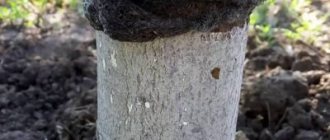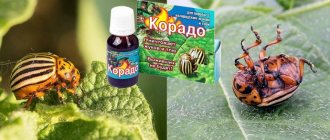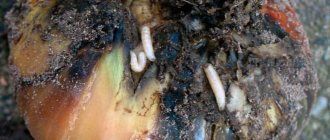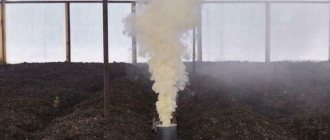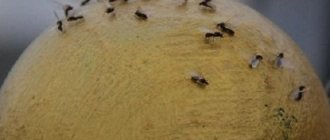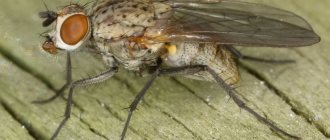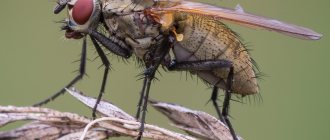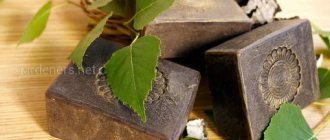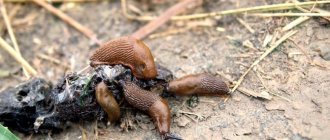Why is tobacco dust needed in the garden? It can be used as a fertilizer due to the fact that it contains nitrogen (2-5%), potassium (1-3%) and phosphorus (1-2%). But it is rarely used in its pure form; as a rule, tobacco dust is used as an additive to mineral fertilizers. It is applied along with spring nitrogen fertilizers before digging the soil in the spring or autumn phosphorus and potassium fertilizers in the fall.
- Tobacco dust: use as an environmental fertilizer
- Tobacco dust from pests
- Pollination of plants and soil with tobacco dust in pure form and mixed with ash or lime
- Decoction and infusion of tobacco dust
- Fumigation of the garden with tobacco smoke
General description and manufacturers of tobacco dust
Tobacco dust is not produced specifically for agricultural purposes. This is a production waste that accumulates in large quantities in factories where cigarettes and cigars are made. This determines the low cost of this plant protection product.
Externally, tobacco dust looks like a gray-brown powder with a characteristic unpleasant odor. For summer residents, it is packaged in thick plastic bags and sold under many brands:
| Trademark | Weight or volume of packaging | average price |
| "Healthy Garden" | 1 kg | 65 rubles |
| "Inta-Vir Bio" | 3 l | 99 rubles |
| "Letto" | 500 g | 45 rubles |
| "Gardener" | 3 l | 110 rubles |
The quality of products from different brands is no different, so you can safely buy what is available in your nearest store.
Ants' appearance and feeding preferences
You may encounter brown, yellow or golden ants up to 3 millimeters in length. Remember that garden and large individuals will never take root in housing. Even if they accidentally ran into it, they will try to leave this area as soon as possible. Therefore, you can either release them into the wild yourself, or wait for their death, which will happen a few days later. At the very least, do not rush to disinfect by looking for a product like Dichlorvos.
House ants are not picky eaters and will pick up everything that comes their way: vegetables, fruits, bread crumbs, leftover fish and meat, cereals, but they give preference to sweets - if you spilled sugar, be sure that every last grain will be found. in the nest. Even the scraps that have accumulated in the trash can are used.
Important: ants cannot survive without free access to water
Tobacco dust as an insecticide: active ingredient
Tobacco powder is officially approved for use on private farms as an environmentally friendly plant protection product.
Even in ancient times, it was noticed that tobacco is the most pest-resistant plant, and insects avoid it. This property has been used to protect cultivated plants since the 16th century.
The effectiveness of tobacco powder against insect pests is due to the presence of nicotine in its composition. This alkaloid, poisonous to humans, is no less toxic to invertebrates. It is not without reason that synthetic analogues, neonicotinoids, were created based on natural nicotine, which are actively used in the agrochemical industry for the production of modern insecticides.
Nicotine acts as a nerve agent on insects. It binds to acetylcholine receptors, blocking them, causing seizures, paralysis and death.
Properties of tobacco
An infusion of tobacco leaves has long been used by experienced gardeners to combat unwanted insects. This product is an excellent alternative to commercial pesticides. These properties of tobacco are explained by the content of the alkaloid nicotine, which is very toxic to pests. Once in the parasite's body, nicotine blocks acetylcholine receptors, which causes the death of the insect.
List of pests sensitive to tobacco dust
Using tobacco powder, you can successfully clean the plant from the following types of pests:
- cruciferous flea beetle;
- all varieties of aphids;
- copperheads;
- leaf rollers;
List of All pests against which tobacco dust is used +6 (click to expand)
- caterpillars of any butterflies;
- cabbage fly;
- Colorado beetle;
- onion fly;
- ants;
- cabbage moth.
The insecticidal activity of tobacco powder against thrips has been noted, but practical use in this case is complicated by the localization of the pest. It is quite difficult to dust flower buds in such a way as to reach the insects hiding between the petals.
In many cases, tobacco dust helps protect plantings not only from insects, but also from mollusks - slugs and snails.
There are no insects that are completely resistant to the effects of tobacco powder, so it can be used to attack any type of pest.
What pests are best used against?
Tobacco dust acts against a number of parasites:
- Aphids - spray leaves with infusion or decoction. After a week and a half, the process is repeated.
- Codling moth. Prepare an infusion for spraying green mass. To do this, pour 0.15 kg of tobacco with hot water and leave for 24 hours. Then filter and bring to a volume of 10 liters.
- Ants, cabbage and onion flies, moths, midges. The soil within a radius of about five centimeters around green spaces is sprinkled with tobacco dust, combined in equal amounts with ash or lime (mixture consumption - 20–25 g/sq. m). Another method is to pollinate the root collars of plants twice during the summer season. Consumption rate – 10 g of product per square meter;
- Medyanitsa. The pest is destroyed by spraying the plants in the bud formation phase or by fumigation after flowering. The procedure is performed in the evening when there is no wind.
- Spider mites on indoor flowers. The procedure is carried out with a decoction after the first infected lesions are detected. After 7–10 days, the process is performed a second time, a third time if necessary.
- Whitefly, thrips, leaf roller caterpillars, ringed silkworms, slugs. The treatment is carried out by spraying a mixture of the drug and lime (in equal proportions). Consumption rate – 20–30 g/sq.m. m. The procedure is performed early in the morning or late evening in calm, calm weather.
- Gooseberry moths, raspberry beetle - treatment with infusion during bud break.
- Cruciferous flea beetles. To destroy them, pollination (20 g/sq. m) is carried out once every 40 days. The mixture is made combined with a share of lime or phosphate rock.
Between treatments of some crops you need to take a break of at least 15 days (cabbage, fruit-bearing crops, tobacco). Some flowers (carnations, gladioli, irises, dahlias, peonies) are treated against parasites with tobacco dust only before and after flowering.
Methods for treating plants with tobacco dust
In practice, tobacco dust is used in two main ways:
- dry pollination;
- spraying with liquid infusions and decoctions.
Tobacco dust is also mixed with the soil in planting holes or burned, fumigating the plants with smoke. The choice of a specific treatment method depends on the pest against which measures need to be taken.
Tip #1. Powdered tobacco has a serious drawback. At least 20 days must pass from the last treatment with this product to harvest. Therefore, it can be used on early ripening crops only in the early stages of the growing season.
What is tobacco infusion used for?
Tobacco is often used as a natural supplement. To make an infusion for this purpose, tobacco dust is used. As a rule, it remains after tobacco production as waste. It can be found on store shelves in gardening departments. Tobacco waste contains phosphorus, potassium and nitrogen. They are so necessary for plants for intensive growth.
Studies have shown that tobacco-based products do not contain hazardous substances and alkaloids that can harm the fruit.
The infusion is non-toxic, has a positive effect on microorganisms in the soil and nourishes the plant with minerals. Thanks to this, the yield increases significantly. This infusion can also be used to fertilize indoor plants. It is especially effective during transplantation for better adaptation.
An infusion of tobacco will also help against pests and parasites: aphids, caterpillars, leaf rollers and others. The product is non-toxic, does not penetrate deep into the plant and does not pollute the soil, unlike chemical insecticides.
Use of dry tobacco dust
You can dust both the plants themselves and the soil around them with tobacco powder. For more even spraying, it is convenient to use a gauze bag. After pouring the product inside, shake the bag over the leaves and shoots or over the soil:
- when fighting aphids, Colorado potato beetles, leaf rollers, thrips, leaf-eating caterpillars, and copperheads, dust leaves, buds and shoots;
- when fighting ants and slugs, dust both leaves and soil;
- When fighting cabbage and onion flies, dust the soil.
This is a very simple method that does not require any preliminary preparation. But it has two drawbacks. Firstly, the product applied in this way only works on the surface and is washed off with the first rain. Secondly, thick dusting of leaves makes photosynthesis difficult. However, dry pollination can be quite effective against pests.
Instead of pure tobacco dust, you can use combined mixtures for the same purposes:
- “Tabazol” is a mixture of tobacco powder and wood ash. Ash in its own way enhances the insecticidal effect by clogging the spiracles of insects. In addition, it provides plants with mineral nutrition. Find out → the use of wood ash as a top dressing, how to dilute it, properties + reviews from gardeners.
- “Tabagor” is a mixture of tobacco and mustard powders. Mustard complements the insecticidal effect of tobacco with bactericidal and fungicidal properties. The product can be used not only to expel pests, but also to prevent infectious diseases that they carry. Find out → the use of mustard as a fertilizer for the garden + reviews from gardeners.
Analogs of these drugs can be made independently by mixing tobacco dust and sifted ash or mustard in equal proportions.
Barring methods
Try methods based on physical barriers. They become an insurmountable obstacle to the ants' path to the plants.
Water barrier. Cut an old car tire in a circle (in half). We make a groove around the tree and put rubber in it, filling it with water. This method has another benefit for the garden. Bees, wasps and birds will drink from the improvised drinking bowl. Some people add pine concentrate to the liquid, which repels harmful insects with its smell.
Scotch belt. To provide protection to currant bushes and other plantings, you can wrap the branches and trunks (10 - 20 cm above the ground) with double-sided tape. This belt is very effective.
Foil skirt. Place foil skirts on tree trunks. The width of the strip is about the palm of your hand. Pull it up a little and tie it in the middle with a rope. Sharp edges will prevent ants from reaching the foliage.
Oil barrier. Coat trees and shrubs with sunflower oil (girdling strips). Insects will not overcome the oil barrier. Our grandmothers lubricated the lower part of the trunks with juice from lupine stems and hemp oil. This is how they protected their gardens from ants.
Try the coffee, gentlemen ants. Mix sugar with instant coffee and pour it into the anthill and along the paths. The relocation of insects is happening for the third time. You can use sleeping coffee that you collect over the winter.
It is recommended to fill anthills with green walnut leaves. The effect is amazing. The ants probably don’t even have time to grab your belongings. Read the article “Get rid of aphids in the garden - the best popular remedies,” we are sure something will help you solve the problem with aphids, and therefore with ants.
Preparation of liquid preparations from tobacco dust
In this case, “liquid preparations” mean decoctions and infusions of tobacco powder. They penetrate deeper into the leaves and do not impede photosynthesis. There are two universal recipes that are suitable for controlling all pests:
| Recipe | Preparation | Sensitive pests |
| Infusion | Brew 100 g of tobacco dust with 1 liter of boiling water, mix well, cover with a lid and leave for a day. Then filter the infusion, dissolve a little laundry or tar soap in it for better adhesion of the product. | Aphids, caterpillars, slugs, leaf rollers, cabbage moths, white moths, cutworms, copperheads. |
| Decoction | Brew 100 g of tobacco dust with 1 liter of boiling water and place on low heat. Boil slowly for half an hour, then cover and cool. After filtering the broth, add a little soap to it. | Colorado potato beetle, thrips and all pests sensitive to simple infusion. |
The infusion or decoction must be filtered very carefully, otherwise small particles of tobacco will clog the sprayer nozzle.
Seedlings of cabbage, rutabaga and other crops dusted with tobacco dust become unattractive to insect pests or slugs. At the very early stage of the growing season, this processing method is most effective.
Before treatment, the sprayer is set to a fine spray so that the solution covers the leaves and shoots well and does not roll off in drops. To completely get rid of insects, you will need 2-3 procedures with an interval of 5-7 days.
Using a decoction you can expel ants from the area. In this case, there is no need to filter the product. The manipulation is performed as follows:
- the broth is poured into a watering can;
- remove the strainer from the spout;
- The anthill is poured generously with the broth.
The liquid will penetrate inside the ant’s home, and the tobacco pulp will remain on the surface.
Important! It is not advisable to use infusions of tobacco dust after fruit set. Nicotine is able to penetrate the fetal membrane and accumulate in its tissues. If you still have to do this, you must strictly observe the frequency of processing and maintain a waiting period of at least 20 days.
General rules for insect control
If you notice only one or two ants indoors, then perhaps these are scouts exploring the area.
In this case, it is enough to destroy the scouts and carry out preventive work to repel insects and prevent invasion. We will also talk about ways to scare away ants in this article. But if you find more than one or two insects, then this is a sure sign that the ants have already made a nest somewhere nearby. Another alarming sign is the appearance of winged flying ants. This is not a special species, but only males and fertile females that become active for a short time during the mating period.
The principles below will tell you how to eradicate an ant infestation in your home and prevent it from happening again.
Be prepared for the fact that it will take time for ants to disappear from your home, especially small red ones, since they can be completely removed only by destroying that part of the colony that is hidden from view.
The fact is that the queen, or queen, who lays eggs in a secluded place, never leaves the nest. She feeds on what the worker ants, who are responsible for feeding the family, bring - the same ones that scurry around the kitchen and spoil the food. The queen remains in place and is constantly busy producing more and more ants. The more workers you kill, the more diligently she will replenish their ranks.
When ants are in the house, the next thing you should do to understand how to remove them is to observe. Working insects, the so-called foraging ants, are busy searching for food. And as soon as the ant finds it, it drags the tasty morsel into the nest, leaving a pheromone trail along the way. In this way, it creates a chemical route for other foragers to collect more food.
By spraying an aerosol, you will simply kill some of the working insects, and the colony will send the next batch in their place, and you will never get to the queen.
Instead of killing worker ants, use them! Forager ants are your guide to the family’s den. Buy ready-made bait stations or ant baits in gel form, or make your own. Place them along the ant trails you have tracked. The workers will find the bait, bring it to the nest and feed the queen, eventually killing her and destroying future generations.
In this effective way, you can remove ants from your home once and for all, using the means available at home. For example, boric acid.
be patient
In the fight against house ants, patience and persistence are the key to victory. Often people do not complete the task because they quickly give up, expecting too quick results. If you see that the ants have taken away the laid out bait, simply renew it.
For baits to work effectively, other food sources should be avoided, that is, cleanliness must be maintained. But at the same time, it is necessary not to wash away the pheromone traces on the beaten ant paths, because these routes should lead the ants to the baits laid out along the way.
Until the ants hatch, keep the house clean, taking into account the biological specifics of their behavior. Do not thoroughly wash the routes of their movement on which the bait is laid out.
These tiny creatures enter the premises of a private or country house through the smallest cracks. To prevent this, seal voids around window and door openings and where electrical wiring and pipes enter the building. Tightly caulk the joints in the walls of a wooden house made of logs or timber, as well as in the plank floors and ceilings, in order to maximally block the ants' access to the living space.
In the fight against domestic ants, it is worth considering some points:
- If there are ants in the house, measures to destroy them must be taken quickly. Ants multiply at an enviable speed and are capable of turning any home into an “anthill”.
- The bulk of poisonous baits and traps for insects are placed in places where they are most concentrated (usually the kitchen, bathroom). All possible routes through which insects enter the house are treated with poison.
- Preventative measures should be applied to the entire room, even those rooms where insects have not been noticed (they can get there very quickly). In cabinets, boxes, and chests of drawers, place bags and bags of herbs and spices that repel insects. Substances with similar effects are used to treat baseboards and ventilation openings.
Tobacco dust as soil fertilizer
Tobacco mixtures “Tabazol” or “Tabagor” are also suitable for preparing liquid preparations.
With this method of application, a tobacco-ash solution “feeds” the plants better than when dusted. Back in the 80s of the 20th century, Soviet agronomists conducted experiments on the use of tobacco dust as fertilizer. The powder was taken both in pure form and mixed with manure in a ratio of 1:3. These experiments gave very good results. The yields of sugar beets and winter wheat increased by at least 20%, and the quality of the products did not deteriorate (see → various types of manure and their use in the garden).
In our time, research on this topic has resumed. In particular, a series of experiments was carried out by researchers from the Kuban Agrarian University. Mixing tobacco dust with microbiological preparations that accelerate the decomposition of organic matter, they introduced it into the soil:
“As a result of the experiments, an increase in the content of ammonium and nitrate forms of nitrogen in the soil was established.”
T. Plotnikova, candidate of agricultural sciences Sciences, Head of the Laboratory of Agricultural Technology
The study also showed an increase in the content of exchangeable potassium and phosphorus in the soil. The microbiological activity of the soil did not suffer at all.
The chemical composition of tobacco dust may vary, depending on the type of tobacco used in the factory and the production conditions. On average, the powder contains the following amounts of basic plant nutrients:
- nitrogen – about 5%;
- potassium – about 3%;
- phosphorus - about 2%.
Thus, tobacco dust can indeed be a good fertilizer. The rate for introducing this material into the soil is 8 kg per 10 m2. The powder is scattered over the surface of the soil and embedded to a depth of 5-10 cm. After this, the plot is spilled with a solution of an EM preparation that accelerates the decomposition of organic matter, and mulched to preserve moisture. After a week, you can sow seeds or plant seedlings on a bed prepared in this way.
To reduce the consumption of tobacco dust, it is not necessary to apply it to the soil in a continuous manner. You can pour it into the planting holes, mixing it with the soil.
Time and frequency of application
Regardless of the method, it is recommended to use tobacco dust early in the morning in calm weather during spring and autumn digging of soil at the rate of 2–4 grams of dust per 1 square meter. The procedure is repeated every two weeks and after each rain, but no later than two weeks before flowering and harvesting. In the latter case, nicotine can affect the formation of the taste of vegetables, fruits and berries.
Attention: you cannot poison parasites two weeks before and during the flowering of plants, because the specific smell of tobacco repels insects that pollinate flowers.
Tobacco dust is used together with such auxiliary components as shag, wood ash, lime, soda, laundry soap and water. They change the concentration of the drug, so the tobacco becomes less free-flowing if we are talking about dust, or more sticky if it is a liquid, and in any case less toxic when in contact with human skin and mucous membranes.
Tobacco dust is convenient to store, transport and use. It is stored in a dark, dry and cool place for no more than one year in a tightly sealed container. It is harmless to humans and covers a wide range of garden parasites. However, when working with tobacco dust, you should wear rubber gloves, a respirator or a gauze mask. If the product gets on exposed skin or on the mucous membrane of a person, it should be washed off under running water.
Precautions when using tobacco dust
Tobacco dust is a material that can have a toxic effect on humans. In particular, workers in tobacco production often experience symptoms such as headache, atrophy of the nasopharyngeal mucosa, ulcers on the gums, conjunctivitis, chronic bronchitis, and high blood pressure.
Of course, one-time use of tobacco powder will not cause such consequences. And yet, when working with it on the site, precautions must be taken. Protecting your nose and mouth from inhaling this material is essential. Goggles and gloves will also come in handy.
Tobacco dust is low-hazard for bees (hazard class III). However, this does not eliminate the need to comply with environmental regulations when working with drugs. Plant treatment should be done in the evening, when the bees have finished flying. The next day it is better to keep them in the hive. The wind speed when spraying tobacco dust should not be higher than 3 m/s.
Using tobacco against pests
Usually they use tobacco infusion, which is very effective. The product is non-toxic and does not pose a danger to plants.
Preparing the infusion is quite easy:
- 400 g of dry tobacco leaves are poured with water (10 l).
- Then they insist for two days.
- Then the solution is filtered, squeezing out the grounds and diluted with water.
To make the infusion stick better, crushed soap is added to it. The prepared solution is sprayed onto infected crops. To completely get rid of pests, the treatment procedure is carried out every week.
Reviews about the effectiveness of tobacco dust
Tobacco dust is a very popular remedy among Russian summer residents. Many people use it not only by dusting or spraying, but also successfully fumigate greenhouses with tobacco smoke:
“I use tobacco dust very simply - I make a smoke smoke. In the evening, I put several scoops of smoldering coals from the bathhouse into an iron bucket and put it in the greenhouse. I throw a few handfuls of dust on the coals, close the greenhouse and go to bed. In the morning I open it and air it out. The smell, of course, lasts for a long time, but I don’t have any aphids or whiteflies. Another thing I like about fumigation is that the smoke does not penetrate into the fruits of tomatoes and peppers, like a decoction” (Elena, Omsk).
Precautionary measures
When using tobacco dust, remember safety precautions:
- When working with the drug, wear rubber gloves, a mask of cotton wool and gauze (respirator).
- When preparing an infusion or decoction, do not use kitchen utensils or utensils.
- When processing a greenhouse, go outside while it is fumigating.
If tobacco dust gets on your skin or mucous membranes, rinse thoroughly and generously with clean running water. This will help you avoid allergies and even minor burns.
The people who work most successfully in vegetable growing are those who love nature, have a special vision for the most insignificant changes in the life of plants, know how to evenly distribute physical activity, and patiently do their work.
Oleg Ivanovich Pomidorkin possesses all these qualities - an active person, a certified specialist, a true expert in his field. But the work of a vegetable grower, like any other work in agriculture, requires, in addition to knowledge of the specifics of growing and caring for plants, physical effort.
You must be able to loosen the soil, weed the plantings, add soil, work with fertilizers, and prepare vegetable seeds for sowing. Then sow them with vegetable seeders or by hand and lime the soil.
Currently, Oleg Ivanovich applies the knowledge accumulated over 43 years of practical activity on his site, which he has been successfully engaged in for more than 10 years.
Ants on the site: benefit or harm?
First, it's important to understand one thing: ants are almost inevitable. They come thoroughly and for a long time, build their shelters and create entire colonies. Most often they appear in the most inappropriate places - in the middle of a plantation or between berry bushes.
There are no truly effective measures that would help prevent the attack. Ants prefer to settle in good fertile soil, in warm areas with healthy humidity. But let's first figure out what the real harm is from uninvited guests and is there any benefit from them?
Photo: vpr.org
We know from school that ants are forest orderlies, because they destroy small pests on an astonishing scale. There are literally thousands and kilograms of larvae, beetles, caterpillars and ovipositors. But at the same time, they “breed” aphids, which then consume all fruit and berry plantings.
Soil with ants is 2 times richer in potassium and as much as 10 times richer in phosphorus, and in the form in which they are best absorbed by plants. But ant colonies irreversibly damage everything in their path. They readily feed on roots, berries and leaves themselves. They like sweet flowers or buds, and over time they can even move into the house.
Photo: factroom.ru
Biological ways to get rid of ants
Ants do not like strong odors. Therefore, as such repellents, you can place the following fragrant products and plants next to the anthills (or even better, make infusions of them by pouring 1 liter of hot water over one tablespoon of the crushed ingredient and letting it brew for 2-3 hours):
- Anise leaves
- Elderberry leaves
- Chopped rhubarb stem and leaves
- Orange (citrus) peel
- Vanillin (not vanilla sugar)
- Finely minced garlic
- Birch tar
Water the anthill with infusions several times over two days. You can plant strong-smelling plants near the beds (or directly on them):
- Sagebrush
- Celandine
- Parsley
- White mustard
- Garlic
- Onion
- Marigold
- Marigolds (calendula)
Although, as practice shows, you can often find ants near these plants, or even on them themselves. You can remove ants from the area by attracting a whirligig bird to the area. In addition to ants, this bird also feeds on aphids, as well as various kinds of caterpillars. It is believed that the whirligig is not very afraid of humans and often settles in gardens. As for how to attract it, as far as we know, if a whirligig likes a hollow or birdhouse, then it can throw someone else’s nest out of it and make its own there. The anteater also feeds on ants, but you will hardly be able to attract it to your summer cottage. You can’t buy it either, except perhaps a special product with the same name.
